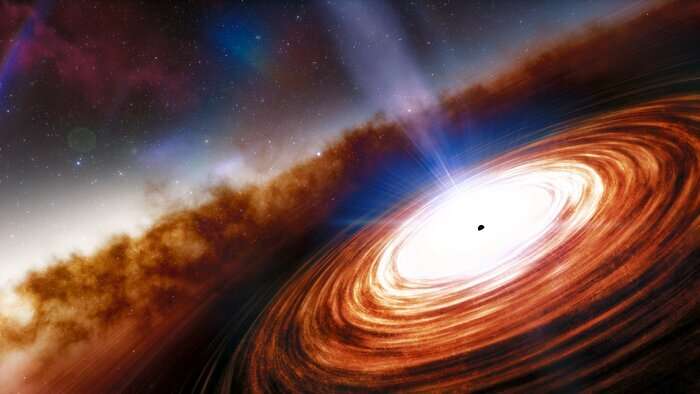The most powerful quasar of the last 9 billion years observed in X-rays
Research led by Elias Kammoun, a post-doctoral fellow at the Institut de Recherche en Astrophysique et Planétologie (Université Paul Sabatier de Toulouse, CNRS and CNES), has revealed the existence of a highly luminous quasar called SMSS J114447.77-430859.3, or J1144 for short, located 9.6 billion light-years from Earth. Quasars are extremely bright, distant objects in the universe, powered by gas falling into supermassive black holes. J1144 is particularly powerful, shining 100,000 billion times brighter than the Sun, making it the brightest quasar observed in the last 9 billion years of cosmic history. The aim of the study was to understand the inner workings of quasars and their interactions with their environment.

Using several space observatories, including eROSITA, XMM-Newton, NuSTAR and Swift, researchers observed X-ray emissions from J1144. They measured the temperature of the emitted X-rays, which amounted to around 350 million Kelvin – more than 60,000 times the temperature at the Sun’s surface. The mass of the black hole at the center of the quasar was estimated at about 10 billion times the mass of the Sun, and it was found to be growing at a rate of around 100 solar masses per year.
Interestingly, the X-ray emission from J1144 varied on a timescale of a few days, which is unusual for quasars with such massive black holes. Usually, such variability is observed over periods of several months or even years. The observations also revealed that, while some gas is absorbed by the black hole, powerful winds eject some of the gas, injecting a significant amount of energy into the host galaxy.
J1144 stands out for its spectacular luminosity and remarkable proximity to Earth, especially in comparison with other similar quasars, offering a unique opportunity to study powerful quasars in detail. Observing such sources contributes to a better understanding of the growth and evolution of black holes across cosmic epochs. The team plans to continue monitoring J1144 to uncover more information about this extraordinary source.
Further Resources
- Scientific publication : E S Kammoun et al, The first X-ray look at SMSS J114447.77-430859.3: the most luminous quasar in the last 9 Gyr, Monthly Notices of the Royal Astronomical Society (2023). DOI: 10.1093/mnras/stad952
- Press review :
- An X-ray look at the heart of powerful quasars (Phys.org)
- eROSITA sees changes in the most powerful quasar (Max Planck Institute for Extraterrestrial Physics)
- An X-ray look at the heart of powerful quasars (CalTech)
IRAP Contact
- Elias Kammoun, ekammoun@irap.omp.eu






